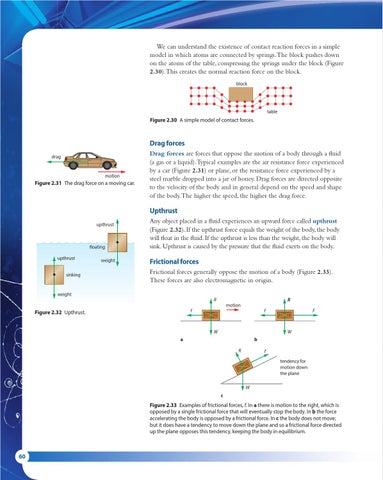We can understand the existence of contact reaction forces in a simple model in which atoms are connected by springs. The block pushes down on the atoms of the table, compressing the springs under the block (Figure 2.30). This creates the normal reaction force on the block. block
table
Figure 2.30 A simple model of contact forces.
Drag forces drag
motion
Figure 2.31 The drag force on a moving car.
Drag forces are forces that oppose the motion of a body through a fluid (a gas or a liquid). Typical examples are the air resistance force experienced by a car (Figure 2.31) or plane, or the resistance force experienced by a steel marble dropped into a jar of honey. Drag forces are directed opposite to the velocity of the body and in general depend on the speed and shape of the body. The higher the speed, the higher the drag force.
Upthrust upthrust
floating upthrust sinking
weight
Any object placed in a fluid experiences an upward force called upthrust (Figure 2.32). If the upthrust force equals the weight of the body, the body will float in the fluid. If the upthrust is less than the weight, the body will sink. Upthrust is caused by the pressure that the fluid exerts on the body.
Frictional forces Frictional forces generally oppose the motion of a body (Figure 2.33). These forces are also electromagnetic in origin.
weight
R f
Figure 2.32 Upthrust.
R
motion
f
W
F
W
a
b R
f tendency for motion down the plane W
c
Figure 2.33 Examples of frictional forces, f. In a there is motion to the right, which is opposed by a single frictional force that will eventually stop the body. In b the force accelerating the body is opposed by a frictional force. In c the body does not move; but it does have a tendency to move down the plane and so a frictional force directed up the plane opposes this tendency, keeping the body in equilibrium.
60
